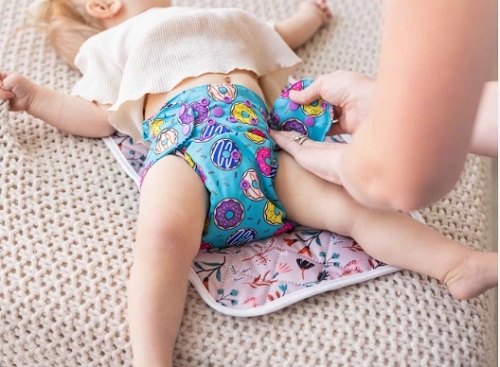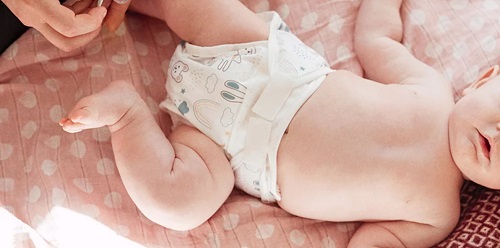Cloth diapers are a great option for parents looking for an eco-friendly and cost-effective solution for their newborns. Unlike disposable diapers, cloth diapers can be reused and washed, reducing waste and saving money in the long run. Understanding how to use cloth diapers properly can make the process smoother and more comfortable for your baby. This guide will walk you through why cloth diapers are a great choice, how to use them effectively, how often they should be changed, and tips for keeping them clean. Whether you’re new to cloth diapering or looking to refine your approach, this guide provides all the essential information to get you started.

Why Choose Cloth Diapers for Your Newborn?
Parents often choose cloth diapers for their newborns because of the environmental and health benefits. Cloth diapers are made from soft, breathable fabrics that are gentle on a newborn’s sensitive skin, reducing the risk of diaper rash. Additionally, they are free from harmful chemicals found in many disposable diapers. Economically, while the initial investment might seem higher, cloth diapers save money over time as they are reusable, lasting through multiple children. Lastly, choosing cloth diapers significantly reduces the amount of waste that ends up in landfills, making them a more sustainable option for environmentally-conscious families. These factors make cloth diapers a beneficial choice for both babies and the planet.
How Do You Properly Put on a Cloth Diaper?
Using a cloth diaper may seem intimidating at first, but once you break it down into steps, it’s quite simple. Below is a step-by-step guide to help you properly put on a cloth diaper and ensure your newborn’s comfort.
Step 1: Prepare the Diaper
Before you begin, make sure you have all the necessary components of the cloth diaper ready. This may include a prefold or insert for added absorbency, along with the diaper cover. Lay the diaper out flat on a clean surface and insert any necessary absorbent liners or inserts into the diaper. For newborns, using a smaller insert designed for their size will offer better fit and absorbency. Having the diaper prepped and ready beforehand will make the process quicker and more efficient, ensuring your baby remains comfortable during the change.
Step 2: Position the Baby
Once the diaper is prepared, carefully place your newborn on their back on a clean, soft changing pad. Lift their legs gently and slide the diaper under their bottom, making sure the back of the diaper is positioned at their waistline. The goal is to position the diaper so that it covers the baby securely without being too tight. Ensuring the diaper is properly aligned is crucial for preventing leaks and ensuring your baby’s comfort. The diaper should fit snugly around the waist without restricting movement.
Step 3: Secure the Diaper
After positioning the diaper under your baby, it’s time to fasten it. Pull the front of the diaper up and over their belly, making sure it covers the diaper liner. Secure the diaper by fastening the tabs or snaps on both sides, ensuring a snug but not too tight fit. Adjust the diaper as needed to make sure the leg openings aren’t too loose or tight. If you are using a cloth diaper with Velcro or snaps, make sure the fasteners are aligned correctly, as a proper fit will help prevent any leaks while keeping your baby comfortable.

Step 4: Check for Comfort
Once the diaper is fastened, double-check that the fit is comfortable for your newborn. Make sure the diaper fits comfortably around the waist and legs to avoid causing any discomfort or irritation. The diaper should be snug enough to prevent leaks but loose enough to allow for movement. Run your fingers along the edges of the diaper to ensure no fabric is bunching up or pinching your baby’s skin. Making these small adjustments ensures that your baby remains comfortable, dry, and happy while wearing the diaper.
How Often Should You Change Cloth Diapers?
Newborns typically need their diapers changed frequently, and cloth diapers are no exception. It’s generally recommended to change your baby’s cloth diaper every two to three hours, or immediately when it becomes wet or soiled. Cloth diapers do not contain the same moisture-wicking chemicals as disposable diapers, so it’s important to monitor the diaper’s wetness to avoid diaper rash. Additionally, changing the diaper promptly helps to keep your baby’s skin dry and prevents irritation. During nighttime, consider using an extra insert for added absorbency, which may allow for longer intervals between changes without compromising comfort.
What Are the Best Cloth Diaper Care Practices?
Proper care for your cloth diapers ensures they remain in good condition and perform well for a long time. After use, rinse off any solids from the diaper into the toilet and store the soiled diaper in a wet bag or diaper pail until laundry day. When washing cloth diapers, use a gentle detergent free of fragrances and additives, as harsh chemicals can affect the diaper’s absorbency. Avoid using fabric softeners or bleach, as these can damage the diaper fabric. It’s recommended to wash the diapers in warm or hot water to remove bacteria, and whenever possible, line-dry them in the sun to naturally disinfect and remove stains.
Conclusion
Using cloth diapers for your newborn is a simple, sustainable, and cost-effective option once you understand the basics of how to use cloth diapers. By following these steps to properly put on a cloth diaper, change it frequently, and care for it, you’ll be able to provide your baby with a comfortable diapering experience that’s also environmentally friendly. Cloth diapers not only help reduce waste but also offer a gentler option for your baby’s skin. With the right approach, you can make cloth diapering a convenient and rewarding choice for both you and your little one.
FAQs:
FAQ 1: How many cloth diapers will I need for my newborn?
For a newborn, it is recommended to have at least 20 to 24 cloth diapers on hand. This amount ensures you have enough diapers to rotate through while washing others. Depending on how often you plan to do laundry, having more or fewer diapers may be suitable for your needs.
FAQ 2: Can I use cloth diapers overnight?
Yes, you can use cloth diapers overnight. For overnight use, consider adding an extra insert for increased absorbency. Many cloth diaper brands offer overnight inserts or boosters that provide the additional protection needed to keep your baby dry and comfortable through the night.
FAQ 3: Are cloth diapers better for newborn skin?
Cloth diapers are often considered better for newborn skin because they are made from natural, breathable fabrics that are gentle on sensitive skin. Since they do not contain the chemicals found in many disposable diapers, they reduce the likelihood of skin irritation or rashes, making them a good option for babies with sensitive skin.
